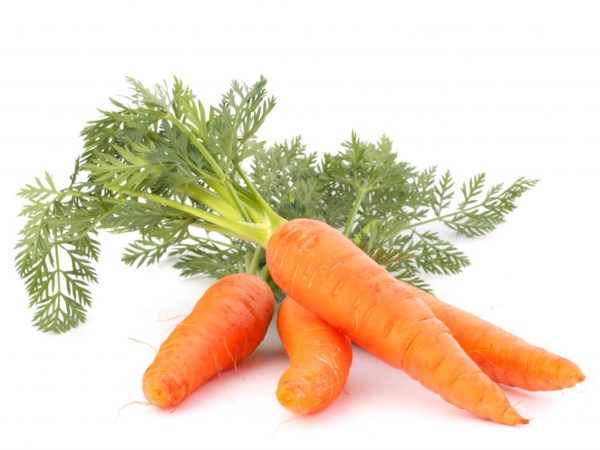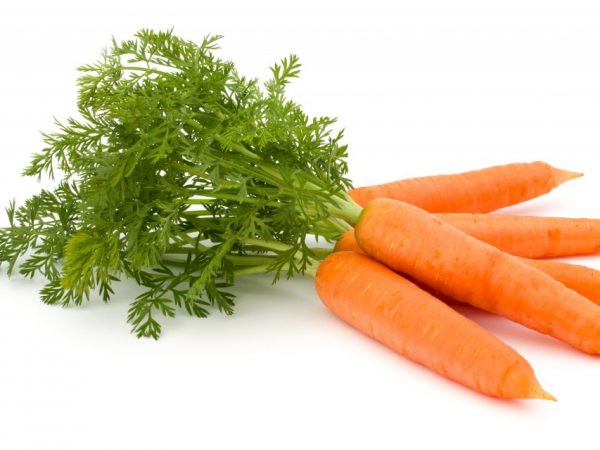Carrot Santa Cruz F1
Santa Cruz F1 carrots have a sweet taste. Knowing the features highlighted by breeders, even beginners in gardening are able to achieve a rich harvest of this crop.

Carrot Santa Cruz F1
Characteristic
This new Dutch variety has the following benefits:
- high yield (95-120 t / ha);
- early maturity
- marketable type of products;
- great taste;
- unpretentiousness to the soil;
- disease resistance;
- resistance to mechanical damage;
- frost resistance;
- shelf life until May.
Description of the variety
The hybrid is highly productive. Its main advantages are resistance to leaf branching and root cracking during harvest. Early ripening: 110-115 days after sowing.
Description of the bush
Medium-sized plant with strong, erect leaves. A healthy bush is dark green.
Description of fruits
Santa Cruz fruits are prized for the following qualities:
- uniform germination and growth;
- large, oblong roots with a blunt tip,
- short length, on average it is 16-18 cm;
- wide base, the diameter of which is 4-6 cm;
- vigorous orange color both outside and inside;
- a large amount of carotene in juicy sweet pulp;
- small core.
Growing
The process of growing a variety is not laborious. The quality of root crops is determined by the special growing conditions of the culture.

Good carrots grow in good soil
Disembarkation
Properly prepared soil is the basis of an exemplary harvest:
- Cultivation is allowed with ordinary (including heavy) soils with a slightly acidic or neutral environment.
- Suitable predecessors are early maturing crops.
- Since autumn, after harvesting, organic fertilizers are applied. It is useful to use manure, peat, ash, urea, sawdust mulching. This is already unacceptable before spring plowing: the final shape of the fruit will be ugly, and the risk of being hit by a carrot fly will also increase.
- Before the formation of the beds, it is advisable to carry out disinfection. Dilute a weak solution of potassium permanganate in combination with hot water.
- As an option, the soil is treated with Fitosporin-M, Rizoplan or Trichodermin.
Any species is returned to its original place of sowing no earlier than after 3-4 years.
The cultivation technology uses a ridgeless planting in April or May (the air temperature should be at least 4 ° C-6 ° C). Such methods are widespread:
- Ordinary. The distance between the rows is 10-25 cm.
- Seeds on a tape. There is no need for thinning. They sell ready-made versions of tapes, but it will be more profitable to make homemade ones from cloister and toilet paper.
- To accelerate growth, germinated embryos are planted. Subsequently, they need frequent watering.
Sow in wet holes 1.5-2 cm deep. Given the climatic conditions, the first shoots appear in 2-3 weeks.
Care
Santa Cruz is demanding about light. Without proper lighting, the fruit is pulled out.
Plants are cold-resistant - they can withstand frosts from -3 ° C to -5 ° C. Long-term frosts promote blooming. The optimum temperature is 18 ° C-25 ° C.
The culture needs constant loosening of the soil.
Fertilizers
The fertilization period is divided into 3 stages: main, pre-sowing (starting) and during the growing season. Types of additives:
- Nitrogen. It determines the yield. The nitrogen application rate is 20% in the fall, 40% in the spring and 40% during the season.
- Phosphorus. He is responsible for the formation of roots. As a preparation, 60% is applied in the fall, the remaining 40% - in the spring.
- Potassium. It increases drought resistance and frost resistance. A sufficient dose has a positive effect on the yield: taste and color are improved. It is used like phosphorus.
- Trace elements: boron, copper, molybdenum. These elements increase the amount of sugar, carotene and minerals in carrots. Irrigated by drip.
Watering
Circular, drum irrigation methods are suitable, but the drip approach is considered the best: this way the water flows directly to the root system. The procedure is repeated every day.
Watering is done more abundantly when:
- seeds germinate;
- fruit width reaches 5-7 mm before ripening.
2-3 weeks before harvesting, the soil is allowed to dry out.
Diseases and pests

Prevention never hurts
There are few insects that damage carrots. The F1 hybrid has inherited resistance to such germination threats:
- alternaria (black rot);
- red leaf syndrome.
If the plantings are damaged, take all the necessary measures to protect the plant.
Treatment of diseases
Diseases affecting culture are bacterial in nature:
- phomosis;
- bacteriosis;
- white rot;
- rhizoctonia (felt rot).
Prevention and at the same time treatment is the observance of basic agrotechnical techniques.
Getting rid of pests
Pest insects usually attack bushes in the early stages of development. The most common pests:
- Carrot fly. Treatment with chemicals "Aklellik", "Tsiper", "Sharpey" and ammonia helps.
- The beetle lays eggs on the tops. They are removed, the bush is watered with soapy water.
- Umbrella moth. To get rid of the parasite, mechanically remove all damaged parts of the plant, then spray the carrots with lepidocide.
- The wireworm is not resistant to ammonia.
Prophylaxis
A culture with a balanced diet and optimal water supply is more resistant to bacterial, viral and fungal diseases. Spring treatment with special insecticides helps against many insects.
Conclusion
Currently, the market requirements for product quality are increasing every year, only hybrids are able to meet them. Santa Cruz F1 is one of them.


